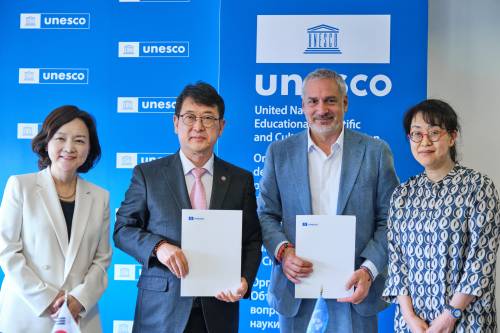Living heritage is a source of identity, well-being and cohesion to communities around the world. When integrated into school-based education, it cultivates a sense of belonging and continuity in young learners. UNESCO’s latest pilot project ‘Teaching and learning with living heritage in Ukraine’ aims to use education as a channel for communities to transmit their culture as well as to achieve a more inclusive and equitable education in line with the 17 Sustainable Development Goals.
Fifteen primary and secondary schools across Ukraine, including 10 UNESCO Associated Schools, participate in this project to integrate living heritage into school subjects like mathematics, physics or literature. In the region of Kharkiv, a team of teachers and students from the Krasnokutsky Lyceum have worked on integrating the tradition of mazanka (mud hut) across several subjects of their curriculum. The team visited nearby villages to observe mazankas dating from the early 20th century. ‘We realized that all of them were built using the same rules, with 100% natural materials’, said Natalya Momot, the project coordinator.
“We study Ukrainian culture, amulets, etc., because these are our memories, which we must transmit”- Olesia, student
For the physics class, teachers and students built three models of houses in brick, wood and plaster to better understand their isolation characteristics. ‘We will heat these huts and take temperature measurements to find out their thermal conductivity’, added Natalya Momot.
For chemistry, the students will create a chalk mixture to whitewash the plastered houses. As a final activity, the students will learn about the traditional techniques of building mazankas by helping a local community to restore one of their mud huts.
The project builds on the positive results of the joint UNESCO-European Union project ‘Teaching and learning with living heritage’, which was implemented in close cooperation with the network of UNESCO Associated Schools in Europe (ASPnet) from 2020 to 2021. The Resource Kit for Teachers developed as part of this project will be translated and adapted to the Ukrainian context, allowing for the methodology to be further replicated and benefit the youth across Ukraine.
The pilot project is implemented in collaboration with the Development Center ‘Democracy through the Culture’ and the UNESCO Chair in Science Education in Kyiv, and demonstrates the role culture can play in recovery and reinforcement of cultural diversity in emergency contexts.
Proyecto:
-
Supporting the resilience of Ukrainian school children through enhancing awareness of their living heritage (1 de septiembre de 2022 – 1 de mayo de 2023)








